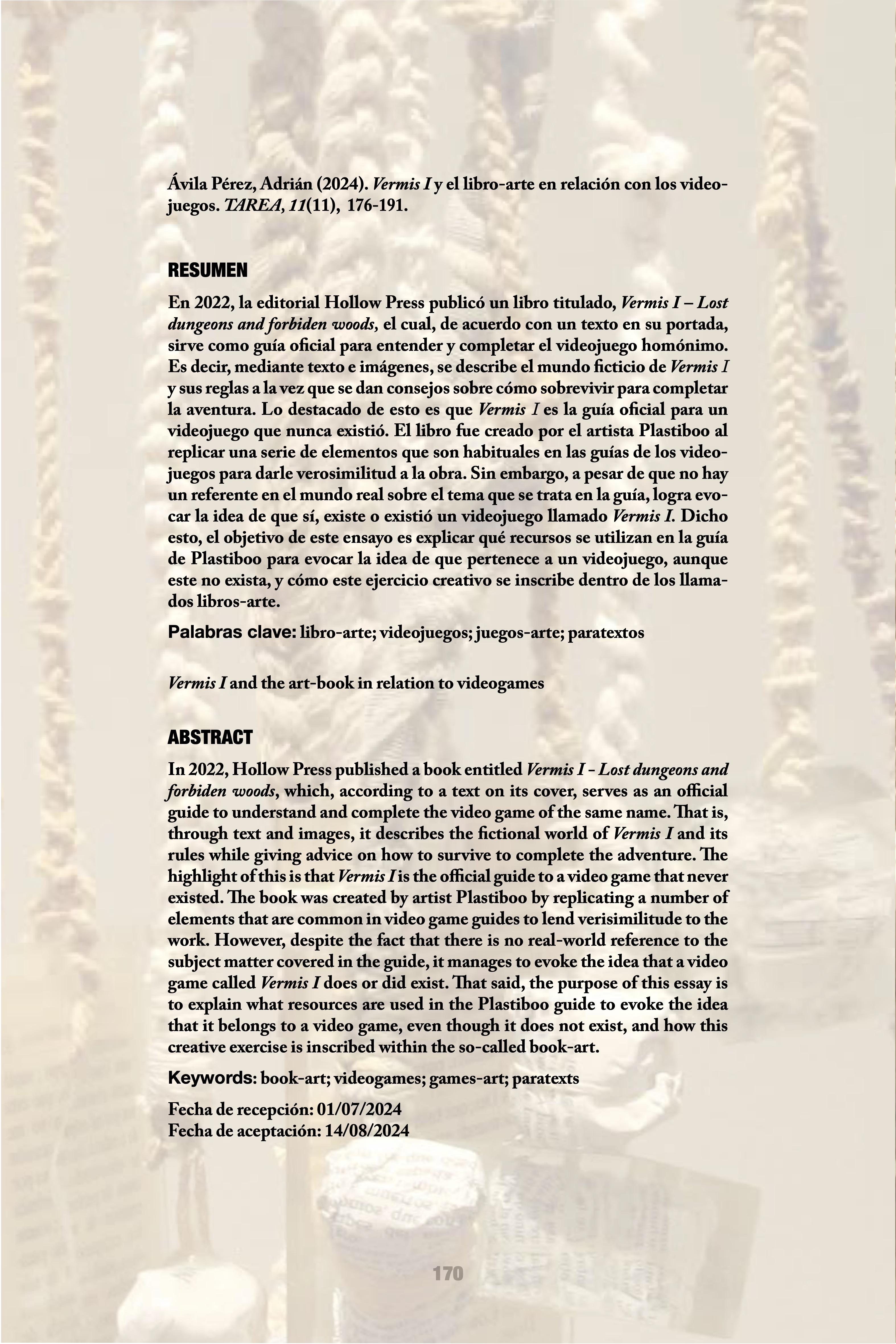Vermis I and the art-book in relation to videogames
Keywords:
book-art, videogames, games-art, paratextsAbstract
In 2022, Hollow Press published a book entitled Vermis I - Lost dungeons and forbiden woods, which, according to a text on its cover, serves as an official guide to understand and complete the video game of the same name. That is, through text and images, it describes the fictional world of Vermis I and its rules while giving advice on how to survive to complete the adventure. The highlight of this is that Vermis I is the official guide to a video game that never existed. The book was created by artist Plastiboo by replicating a number of elements that are common in video game guides to lend verisimilitude to the work. However, despite the fact that there is no real-world reference to the subject matter covered in the guide, it manages to evoke the idea that a video game called Vermis I does or did exist. That said, the purpose of this essay is to explain what resources are used in the Plastiboo guide to evoke the idea that it belongs to a video game, even though it does not exist, and how this creative exercise is inscribed within the so-called book-art.
References
Berger, J. (2019). Modos de ver. Gustavo Gili.
Clüver, C. (2007). Intermediality and Interarts Studies. En J. Arvidson, M. Askander, J. Bruhn, y H. Führer (Eds.), Changing Borders.
Contemporary Positions in Intermediality (pp. 19-37). Intermedia Studies Press.
Crespo Martín, B. (2010). El libro-arte. Clasificación y análisis de la terminología desarrollada alrededor del libro-arte. Arte, Individuo y Sociedad, 22 (1), 9-26.
Crespo Martín, B. (2012). El libro-arte / libro de artista: tipologías secuenciales, narrativas y estructuras. Anales de documentación, 15(1), 1-25.
Esposito, N. (2005, junio 16-20). A Short and a Simple Definition of What a Videogame Is. Digital Games Research Conference. http://www.digra.org/digital-library/publications/a-short-and-simple-definition-of-what-a-videogame-is/
Genette, G. (1989). Palimpsestos: La literatura en segundo grado. Taurus.
Genette, G. (1997). Paratexts: Thresholds of Interpretation. Cambridge University Press.
Giovine, M. A. (2023). Traducción material y traducción medial: dos procesos fundamentales en la producción y circulación del arte moderno y contemporáneo. Nuevas poligrafías: Revista de teoría literaria y literatura comparada, (8), 135-158. https://doi.org/10.22201/ffyl.29544076.2023.8.1909
Iser, W. (2011). La estructura apelativa de los textos. En D. Rall (Ed.), En busca del texto: Teoría de la recepción literaria (pp. 99-120). UNAM.
Iser, W. (1996). Las relaciones entre el texto y el autor. En E. Sullà (Ed.), Teoría de la novela: Antología de textos del siglo XX (pp. 248-256). Grijalbo.
Klima, S. (1998). Artists Books: A Critical Survey of the Literature. Granary Books.
Lantz, F. (2023). The Beauty of Games. The MIT Press.
Livingstone, I., y Jackson S. (1986). Titan. The Fighting Fantasy World. Puffin Books.
Mitchell, W. J. T. (2009). Teoría de la imagen. Akal.
Plastiboo. (2022). Vermis I – Lost dungeons and forbidden Woods. Hollow Press.
Ryan, M. (2001). Narrative as Virtual Reality. The John Hopkins University Press.
Salen, K., y Zimmerman, E. (2010). Rules of Play: Game Design Fundamentals. The MIT Press.
Sharp, J. (2015). Works of Game: On the Aesthetic of Games and Art. The MIT Press
Stableford, B. (2009). The A to Z of Fantasy Literature. Scarecraw Press.
Stine, R. L., (1986). Busca el tesoro de Hark. Daimon.
Tribe, M., Jana, R., y Grosenick, U. (2009). New Media Art. Taschen.












